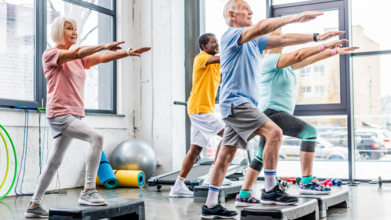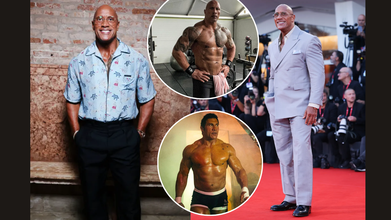- Health Conditions A-Z
- Health & Wellness
- Nutrition
- Fitness
- Health News
- Ayurveda
- Videos
- Medicine A-Z
- Parenting
- Web Stories
Fitness Enthusiast or Desk Worker? Try These 4 Easy Chest Stretches To Instantly Boost Flexibility

Credit: Canva
Chest muscle stretches are essential for maintaining flexibility, reducing muscle tightness, and improving posture. You would wonder who would it benefit? Well, fitness experts say, literally everyone! For fitness enthusiasts, it could relax those tightening chest muscles after reps of pushups or pullups. For desk workers, chest stretches could better their posture and prevent back pain. You see, the default position while working is bent over a computer or a screen, which can be an issue. So, some basic exercises focussed on stretching chest muscles could help them a long way.
ALSO READ: Big Breakfast Reduces Depression Risks In Heart Patients
Here are four chest stretches that improve flexibility and postures:
Whether you're working at a desk all day or recovering from an intense workout, these four simple yet effective chest stretches can help keep your muscles relaxed and mobile.
1. Seated Chair Stretch
This stretch is perfect for those who spend long hours at a desk. You can do it while sitting, making it easy to incorporate into your daily routine.
How to Do It
- Sit upright and interlock your fingers behind your head.
- Gently pull your elbows back until you feel a stretch across your chest.
- If this feels challenging, try the "goalpost" position—bend your arms at 90 degrees with your fingers pointing upward.
- Hold for 3 to 5 seconds and repeat 10 times.
2. Single-Arm Chest Stretch With Rotation
This seated stretch can be done at work or in between strength training exercises, such as a bench press.
How to Do It
- Sit on a chair and hold onto the bottom edge with one hand.
- Push your chest forward and slowly rotate your torso away from the arm gripping the chair.
- Hold the stretch for 3 to 5 seconds before switching sides.
- Complete 10 repetitions on each side.
3. Quadruped Kneel Pectoral Stretch
Ideal as a warm-up or cool-down, this stretch targets the pectoral muscles while improving shoulder mobility.
How to Do It
- Start in an all-fours position (quadruped stance).
- Extend one arm straight out to the side, keeping your palm flat on the floor.
- Gently push your shoulder toward the ground while rotating your torso away from the extended arm.
- Hold for 3 to 5 seconds and repeat 10 times.
4. Scorpion Chest Stretch
This is the most advanced stretch on the list, best attempted after mastering the others. It deeply opens up the chest and improves spinal mobility.
How to Do It
- Lie flat on your stomach with your arms stretched out to the sides at 90 degrees.
- Lift one leg and rotate it across your body until your foot touches the floor, forming a "scorpion" shape.
- Keep your other arm flat on the ground with the palm down for stability.
- Use your free hand to press into the floor, deepening the stretch.
- Hold for 3 to 5 seconds and repeat 10 times per side.
ALSO READ: I Ate No Sugar For 14 Days, Here’s How My Body Reacted
Why “No Time, I'm Very Busy” Is A Poor Excuse For Not Exercising, Here’s The Scientific Proof

Credits: iStock
We all know someone who swears by their morning coffee, a daily multivitamin, or even meditation as a health booster but what studies have relentlessly demonstrated is that there exists one friend that never disappoints, physical activity. Exercise is not merely a way of life—it is a well-documented defense mechanism, with the body and mind being protected from a host of chronic conditions while also encouraging longevity and life quality.
From stronger hearts and bones to sharper minds, the benefits of regular exercise are hard to overstate. And yet, despite overwhelming evidence, inactivity remains one of the leading contributors to disease and decline, particularly among older adults.
Decades of study confirm one thing: exercise is medicine. The CDC observes that older adults who exercise regularly decrease their chances of falls, lower their burden of chronic disease, and even have lower mortality rates. Beyond the body, exercise is good for mental health, delays the onset of dementia, and increases wellbeing overall.
Initiatives such as Exercise Is Medicine (EIM) Active Aging are making these findings real. Physicians are now being educated to prescribe exercise as a regular part of treatment, using instruments such as the Physical Activity Vital Sign (PAVS) to screen for inactivity before it becomes a real problem.
A new 2025 study emphasizes that even when science is unequivocal, practical impediments can stand in the way of exercise becoming an integral part of usual care. Wingood and colleagues created a step-by-step Physical Activity (PA) pathway for therapists who work with older adults. Time pressures, knowledge gaps, and burdensome electronic health records were concerns that at first seemed overwhelming. More than 88% of participating therapists, however, found the pathway practical and useful, illustrating how organized guidance can convert scientific information into actual outcomes.
This strategy is replicated across the world. In Dubai, the "Dubai Will Remain Young" initiative helps people above 60 engage in physical and social activities, balancing fitness and social integration to improve well-being. Likewise, in the United States, the Senate's 2025 hearings on sports medicine reiterated that initiatives such as EIM Active Aging are building a future where organized exercise becomes as much a part of our health habits as regular check-ups.
One of the biggest barriers to exercising with older adults is the attitude that it's hard, time-consuming, or dangerous. The truth is exactly the opposite: greater frequency and intensity of physical activity are associated with improved health outcomes across several fronts, from cardiovascular function to cognitive function. When physical therapists work together with exercise professionals, older adults can trade in sedentary lifestyle for active independence—independence that comes with confidence, mobility, and social interaction that exercise naturally fosters.
As one observer noted, "Travel is changing, and now it is no longer merely a matter of checking off places — it's about what the trip stirs in us. There's an evident shift, as increasingly more travelers look for something more, many are looking for emotional resonance, personal significance, and even healing." Likewise, exercise is no longer peripheral or optional—it's at the heart of wellbeing and longevity.
A Simple Workout Routine to Get Started
Even if you feel you don't have time, small, organized routines can help:
Warm-up (5 minutes): Light marching in place, gentle stretching, or light walking.
Strength training (10–15 minutes, 2–3 times a week):
Bodyweight squats (2 sets of 10–15 reps)
Wall push-ups (2 sets of 10–12 reps)
Seated leg lifts (2 sets of 10–12 reps per leg)
Cardio (10–20 minutes, 3–5 times a week):
Brisk walking, cycling, swimming, or climbing stairs
Flexibility & balance (5–10 minutes per day):
Yoga stretches or tai chi
Walking heel-to-toe for balance
Cool-down (5 minutes): Light stretching, deep breathing, or slow walking
Even brief periods matter. What does is regularity, progressive increase in intensity and variety to keep it interesting and effective.
Exercise is medicine- age, lifestyle, or hectic schedule is no reason. With disciplined methods, assistance by professionals, and dedication to small but regular activity, seniors and adults can change health results, avoid disease, and enhance mental health. Physical activity is not an add-on to healthcare—it is basic, integral, and revolutionary.
AIIMS Gut Doctor Shares 'Japanese Walking' Trend Just For 30 Minutes Could Help Lower Blood Pressure

(Credit-Canva)
Recently a new fitness trend has gained traction on the internet, and many people are sharing their experience trying it.
For many years, we’ve been told that a goal of walking 10,000 steps every day is a great way to stay healthy. This daily habit has been linked to a number of benefits, from reducing the risk of serious illnesses like dementia and heart disease to simply making you feel better mentally.
Japanese walking trend has gained the attention of many people including healthcare professionals. It is a new, more efficient walking technique that can give you even more health benefits without requiring as much time. This method, called interval walking, was developed in Japan and is quickly becoming a popular alternative for people looking to improve their fitness.
In a new video, Gastroenterologist Saurabh Sethi MD, shared how this walking trend could be the best thing for your gut health.
How To Do Japanese Interval Walking?
This simple and effective method was created in Japan and is based on a smart idea: mixing up your walking speed. Instead of walking at the same pace all the time, you alternate between slow and fast. Here is the simple routine:
Start with a Warm-up
Before you begin, walk at a relaxed, comfortable pace for 3 to 5 minutes. This is a crucial first step. Think of it as waking up your muscles and preparing your body for the workout ahead. A good warm-up helps prevent injuries and makes the rest of your walk more effective.
Alternate Your Pace
This is the main part of the workout. You'll switch back and forth between two different speeds. First, walk for 3 minutes at a slow, easy pace. This should feel relaxed, like a leisurely stroll. After that, switch to a brisk, fast pace for the next 3 minutes. This is where you should feel like you're in a hurry, as if you're rushing to an important meeting. This faster pace gets your heart pumping and makes the exercise more intense.
Repeat
Keep alternating between those 3-minute slow and 3-minute brisk intervals. Do this until you have completed a total of 30 minutes of walking. This simple repetition is what makes the workout so effective. It challenges your body in a way that a steady-paced walk doesn't.
End with a Cool-down
Once you've finished the 30-minute main part, slow down to a gentle, easy pace again for 3 to 5 minutes. This cool-down period helps your heart rate and breathing return to normal safely. It also helps your muscles relax, which can prevent soreness later on.
What are The Benefits of Interval Walking
This method is more than just a different way to walk; it's a smart workout. Studies have shown that because you're challenging your body with bursts of faster walking, you get a lot of great health results. Here’s what this technique can do for you:
Improve Your Heart Health
When you change speeds, you make your heart work harder and then allow it to relax. This is excellent training for your cardiovascular system, which is what keeps your heart and blood vessels healthy. The result is a stronger heart and better overall fitness.
Lower Your Blood Pressure and Stroke Risk
Regularly doing interval walking can help bring down high blood pressure. Since high blood pressure is a major risk factor for strokes, this simple routine can significantly reduce your chances of having one.
Boost Your Mood and Immune System
Physical activity helps your body release chemicals that make you feel good and happy. The varied pace of interval walking also helps strengthen your body's natural defenses, making you less likely to get sick.
Get Better Sleep
When you get enough physical activity, you use up energy and help your body wind down. The workout you get from interval walking can help you fall asleep faster and get more deep, restful sleep.
Easy on the Joints and Saves Time
Because you're not constantly walking at a high speed, this method is gentle on your joints. And since you can get all of these amazing benefits in just 30 minutes, it's a very efficient way to fit exercise into a busy schedule.
Dwayne Johnson Unrecognizable New Look Leaves Fans Shocked, How The Rock Dropped 60 Pounds During Weight Loss Transformation

Credits: Venice Film Festival/Instagram
Dwayne “The Rock” Johnson has always been synonymous with strength, charisma, and an iconic muscular frame. But this week, fans barely recognized him. At 53, the actor unveiled a dramatically slimmer look while promoting his latest film, The Smashing Machine, leaving social media buzzing. Dropping an astonishing 60 pounds for his role as MMA champion Mark Kerr, Johnson’s transformation has sparked curiosity, how did one of Hollywood’s most ripped stars achieve such a drastic change and could it really be done safely? From diet tweaks to intense training, this transformation is surely a masterclass in discipline, science, and sheer determination.
From his WWE wrestling days to blockbuster hits like Fast & Furious and Black Adam, his signature look has been about size, strength, and power. But when he stepped onto the red carpet at the 82nd Venice International Film Festival, fans were stunned. Johnson, 53, appeared dramatically slimmer, having shed close to 60 pounds for his role in The Smashing Machine, a biopic about MMA legend Mark Kerr.
Clad in a sharp double-breasted suit and subtle glasses, Johnson looked nearly unrecognizable. Social media lit up with reactions ranging from admiration to disbelief. “The Rock turned into a pebble,” one fan quipped on X, while others speculated whether Hollywood’s latest weight-loss trend—injectables like Ozempic or Mounjaro played a role.
So how did the world’s most famous action star pull off such a radical transformation?
Dwayne Johnson Weight Loss: The Acting Role That Sparked a Transformation
The Smashing Machine, tells the turbulent story of Mark Kerr, a former NCAA wrestling champion; to do justice to Kerr’s complicated journey, Johnson didn’t just rely on prosthetics and wigs. He physically reshaped his body to mirror the leaner, battle-worn frame of an MMA fighter from the late 1990s. Speaking at Venice, Johnson admitted:
“This transformation was something I was really hungry to do. I’ve been fortunate in my career, but there was a little voice inside me that said, ‘What if I could do more?’”
How Did Dwayne Johnson Lost 60 Pounds?
Dropping 60 pounds is not a casual feat, especially for someone with Johnson’s naturally muscular build. It requires precision, planning, and science-backed strategies. Here’s a breakdown of what likely fueled his transformation:
1. A New Approach to Nutrition
Johnson has long been known for his intense, protein-rich “cheat meals” and high-calorie fueling. But slimming down for The Smashing Machine would have meant rethinking everything.
Caloric Deficit: To lose weight, he would have needed to burn more calories than he consumed daily. Reports suggest that his intake was strategically lowered while still supporting performance and energy.
Lean Proteins: While reducing muscle bulk, protein remains essential for muscle maintenance. Sources like grilled fish, egg whites, and lean chicken likely became staples.
Lower Carbs, Smarter Fats: Instead of bulking carbs, Johnson likely shifted toward complex carbs (like sweet potatoes and oats) and healthy fats (avocados, olive oil, nuts).
Hydration and Water Manipulation: A technique Johnson previously described during Black Adam prep. Adjusting water and sodium intake helps achieve a leaner, tighter look.
2. Training Like a Fighter, Not a Bodybuilder
Unlike superheroes or action roles that required maximum size, portraying Kerr demanded a more athletic, fight-ready build. Johnson’s training likely included:
Functional Strength Workouts: More bodyweight exercises, compound lifts, and fight-specific movements rather than sheer heavy lifting.
Cardio Conditioning: Interval training, long sessions of steady-state cardio, and possibly combat drills to replicate an MMA fighter’s stamina.
Mobility & Agility Training: Essential for replicating Kerr’s fighting style and reducing the risk of injury at 53.
Did Dwayne Johnson Use Ozempic or Fat-Loss Injections?
The internet buzzed with speculation about whether Johnson joined the list of celebrities turning to medications like Ozempic or Mounjaro, designed for diabetes but widely used for rapid weight loss.
There’s no confirmation from Johnson himself, and given his history of meticulous training regimens and diet transparency, it seems more plausible that his transformation was the result of strict lifestyle changes rather than pharmaceutical shortcuts.
Still, experts note that rapid and dramatic changes like this are usually only sustainable under professional supervision something Johnson has access to with his longtime trainer, Dave Rienzi.
This isn’t the first time Johnson has dramatically altered his physique for a role. For Black Adam (2022), he revealed how he worked “harder than ever” on dieting and training, manipulating sodium and water retention to achieve a superhero’s shredded frame.
The difference this time? Instead of aiming for mass and density, he trimmed down to reflect vulnerability, endurance, and realism. It’s a striking reminder that body transformations in Hollywood aren’t always about getting bigger—they’re about embodying a character.
Why Are Celebrity Weight Loss Transformations Becoming Popular?
Johnson’s transformation adds fuel to the ongoing discussion about how actors reshape their bodies for roles. Christian Bale, Matthew McConaughey, and Joaquin Phoenix all underwent dramatic shifts for character authenticity. But for Johnson a man defined by his physique it’s particularly startling.
His leaner frame also resonates with broader health conversation and the possible use of weight loss injections to transform into a leaner more "fitter" body. With obesity rates soaring and plant-based diets, intermittent fasting, and medical interventions gaining traction, fans are asking whether their favorite stars are adopting the same tools everyday people use—or something far more extreme.
Fitness Lessons You Can Apply To Your Journey
Dwayne Johnson’s new look may be for a role, but it underscores timeless lessons about health and body transformation:
- Significant weight changes require discipline, nutrition, and tailored exercise.
- Quick fixes, like weight-loss injections, remain controversial and should be supervised by medical professionals.
Even at 53, with the right guidance, it’s possible to reshape your body dramatically though sustainability depends on balance, not extremes.
Johnson has proven once again that his career is about more than action-hero brawn. His latest transformation shows he’s still willing to push physical and emotional limits to tell a story reminding fans that even “The Rock” is capable of change.
© 2024 Bennett, Coleman & Company Limited

